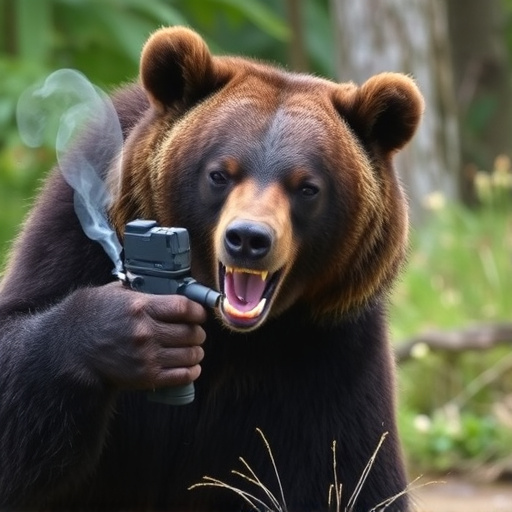Understanding bear behavior and taking preventive measures, such as making noise while hiking and securely storing food, can significantly reduce the risk of encounters in bear-inhabited areas. Bear spray is an effective deterrent when used correctly, with the optimal distance for application typically ranging from 20 to 30 feet (6 to 9 meters). Maintaining a safe distance of at least 100 yards (91 meters) from bears, especially grizzlies, and practicing bear spray use in controlled settings prior to real encounters are crucial safety strategies.
In many outdoor adventure hotspots, encountering aggressive bears is a real concern. Understanding bear behavior and their habitat is crucial for safety in these areas. This article delves into effective strategies for outdoor protection against aggressive bears, focusing on the role of bear spray and practical tips for maintaining an optimal distance. Learn how to navigate these wild encounters with knowledge and preparation. By understanding these tactics, you can enhance your safety when exploring bear country.
- Understanding Bear Behavior and Their Habitat
- The Role of Bear Spray: Effective Deterrent or Not?
- Practical Tips for Maintaining Optimal Distance and Safety
Understanding Bear Behavior and Their Habitat
Understanding bear behavior and their habitat is crucial for anyone venturing into areas where bears are present. These majestic creatures have a complex set of instincts that can make them aggressive if they feel threatened or surprised. Bears are primarily interested in food, water, and protecting their young. They tend to avoid humans unless they perceive a threat or are attracted by food sources like garbage or camp cooking.
Knowing the optimal distance for bear spray is essential in preventing close encounters. Bear spray should be used as a last resort when a bear exhibits aggressive behavior or approaches within a certain range, typically 50-70 feet (15-21 meters). It’s important to remember that prevention methods like making noise while hiking and storing food securely can significantly reduce the risk of an encounter altogether.
The Role of Bear Spray: Effective Deterrent or Not?
Bear spray has long been considered a crucial tool in outdoor safety, especially when navigating bear-inhabited areas. It’s marketed as an effective deterrent, creating a protective barrier between you and aggressive bears. However, the question arises: is it truly as reliable as advertised? The key to bear spray’s success lies in its correct usage and understanding the optimal distance for application.
The recommended range for using bear spray is typically around 20-30 feet (6-9 meters). At this distance, the spray can effectively reach and cover an individual or a group, creating an irritant barrier. However, factors like wind direction, humidity, and the bear’s behavior can significantly impact the spray’s effectiveness. For instance, in windy conditions, the spray pattern may be disrupted, reducing its coverage area. Moreover, some bears may not react as expected, especially if they are defensive but not aggressively charged. Thus, while bear spray is a valuable asset, it should be used as one component of an overall safety strategy when venturing into bear country.
Practical Tips for Maintaining Optimal Distance and Safety
When encountering a bear outdoors, maintaining a safe distance is crucial. It’s recommended to stay at least 100 yards (91 meters) away from bears, especially grizzly bears, which are known for their unpredictable behavior. This distance ensures that you’re not encroaching on their personal space, minimizing the risk of an aggressive response.
For added protection, carrying and using bear spray effectively can be a game-changer. Aim for the bear’s face and eyes when deploying the spray, creating an optimal distance of about 20 to 30 feet (6 to 9 meters). This method temporarily blinds and disorients the bear, providing you with a crucial few seconds to retreat safely. Remember, practice using bear spray in controlled environments before relying on it during encounters.
In understanding bear behavior and their habitat, it’s clear that maintaining a safe distance is paramount. While bear spray has been touted as an effective deterrent, its optimal usage remains a topic of debate. Practical tips emphasize the importance of awareness, noise making, and avoiding unexpected encounters. Ultimately, responsible outdoor enthusiasts should prioritize knowing local bear habits, keeping food secure, and carrying essential safety gear to ensure enjoyable and conflict-free interactions in bear country.
